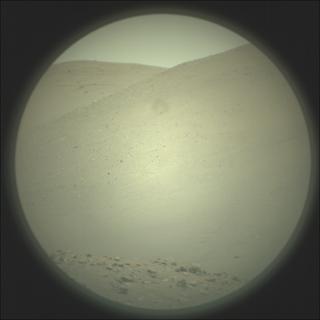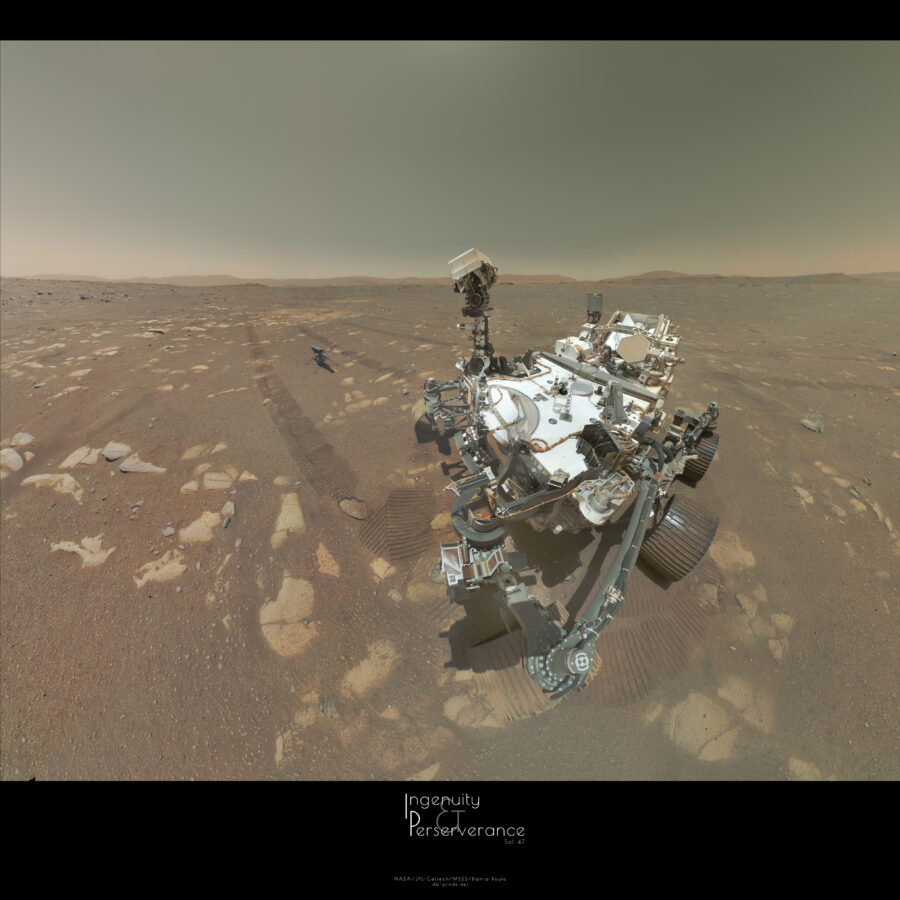https://bit.ly/PercyMAP was updated to include a transparent, 5m tall flight zone. It is currently affected by vertical exaggeration along with the topography.
Little Ingenuity is ca. at the center of the designated airfield, 4m above ground.
Click to view attachment
Full Version: Perseverance - Early Drives
Maybe! It's the same one noted earlier but seen more clearly. Get that laser on it!
Phil
Phil
Maybe! It's the same one noted earlier but seen more clearly. Get that laser on it!
Phil
Phil
It's the same one. they imaged it with a suite of filters, those that know how to interpret those may likely already know if it's Fe-Ni.
My hat is still on the table for eating, but I think I'm safe
EDIT: James Sorenson just told me to look closer at the image. It's already been zapped with SuperCam
It was 5 x 3 dust devil survey. You don't need wide angle to film Ingenuity - they'll be parked >100m away and it's only going 5m high.
Ah, good to know there are such dust devil surveys, especially when they are successful. I think the distance from the Van Zyl overlook to the airfield is about 60m. Would such a distance require a wider than normal field of view for a full length flight down the flight zone ? Certainly not for the initial up and down flights.
The 60m length of the flight zone would subtend around 37 deg from Van Zyl, so easily within the 96 deg horizontal FOV of navcam but outside the max 25.6 deg for MCZ (though with a 2.3 deg toe-in between L and R I guess you could push that a bit).
I imagine that if you lay on the ground and the rover rolled over you you would pick up the sound pretty well. Not that I recommend it.
We'd probably not hear the crunches, splinters and squishes from that over the usual assortment of clangs, sproings, crunches and whirs from the Rover.
--Bill
It looks so shiny like Heat Shield Rock! Can we stuff a piece of it into a tube?
Sadly, no.
There's a reason the MERs never used the RAT on the various metallic meteorites they found; the sparks would have flown! I doubt Perseverance's coring instrument was rated for anything particularly hard; the samples worth collecting are going to be much softer types.
This is also a demonstration of the difference in impact flux between Earth and Mars; every mobile surface mission has come across several during their travels. A combination of the thin atmosphere and being on the asteroid belt's inner edge. Even Antarctica can't compete for meteorite hunting.....
There's a reason the MERs never used the RAT on the various metallic meteorites they found; the sparks would have flown! I doubt Perseverance's coring instrument was rated for anything particularly hard; the samples worth collecting are going to be much softer types.
This is also a demonstration of the difference in impact flux between Earth and Mars; every mobile surface mission has come across several during their travels. A combination of the thin atmosphere and being on the asteroid belt's inner edge. Even Antarctica can't compete for meteorite hunting.....
I'd suspect that Rovers have found frequent meteorites because the iron meteorites would tend to be more resistant to chemical and physical weathering, as well aeolian erosion, than the basalt or weakly cemented sedimentary rocks typically present on Mars.
Also, erosion rates are much slower on Mars so the surfaces are much older than any terrestrial surface, and have just had more time to accumulate meteorites.
John
John
Time to check the wheels!
Well, it's been 39 Sols, and although the rover hasn't really travelled that much, how are the wheels holding up?
Well, very well indeed.
The only obvious anomalies I found are highlighted. The yellow circled area seems to show some "scuff marks". The yellow rectangle shows some loss of the outer layer.
There is also a good sized rock in the wheel (arrow), which as someone previously mentioned, should get polished nicely:
Click to view attachment
Here's a blowup of the scuff marks:
Click to view attachment
All things considered, there's not much to complain about.
Original image
Well, it's been 39 Sols, and although the rover hasn't really travelled that much, how are the wheels holding up?
Well, very well indeed.
The only obvious anomalies I found are highlighted. The yellow circled area seems to show some "scuff marks". The yellow rectangle shows some loss of the outer layer.
There is also a good sized rock in the wheel (arrow), which as someone previously mentioned, should get polished nicely:
Click to view attachment
Here's a blowup of the scuff marks:
Click to view attachment
All things considered, there's not much to complain about.
Original image
Hi Marvin,
I think that the 'scuff marks' are just the underlying color of the wheel (blackish)
There appears to be a very fine layer of Mars dust clinging to the wheel (except for the scuff marks and such that you point out)
Note the color of the near-pristine wheels on the sky-crane:
Click to view attachment
And the almost-pristine wheels after landing (note the black color on top and the red/brown dust clinging to the bottom of the wheel):
Click to view attachment
By the time Percy rolls around, the wheel appears all rusty red-brownish (your images)
That rock will surely get tumbled and probably stay in the wheel -- the fine dust may get blown out
and probably stay in the wheel -- the fine dust may get blown out  -- eventually -- maybe
-- eventually -- maybe
I think that the 'scuff marks' are just the underlying color of the wheel (blackish)
There appears to be a very fine layer of Mars dust clinging to the wheel (except for the scuff marks and such that you point out)
Note the color of the near-pristine wheels on the sky-crane:
Click to view attachment
And the almost-pristine wheels after landing (note the black color on top and the red/brown dust clinging to the bottom of the wheel):
Click to view attachment
By the time Percy rolls around, the wheel appears all rusty red-brownish (your images)
That rock will surely get tumbled
Nothing exposed is pristine after a dynamic landing on dusty Mars...
I think that the 'scuff marks' are just the underlying color of the wheel (blackish)
There appears to be a very fine layer of Mars dust clinging to the wheel (except for the scuff marks and such that you point out)
There appears to be a very fine layer of Mars dust clinging to the wheel (except for the scuff marks and such that you point out)
Interesting how the fine dust sticks to things.
Thanks for the feedback.
Sol 38 anaglyph view of the debris shield lying on the Martian surface. Part of the belly pan is also visible behind a rock a bit to the right.
Click to view attachment
Click to view attachment
The greatest factor hindering meteorite detection on Earth is that meteorites often blend into the scenery. This is why Antarctica and certain deserts are attractive places to look for them and much of the terrain of Earth makes meteorite hunting very difficult. This is why iron meteorites are discovered at a much greater rate than stony ones, relative to their intrinsic abundance, and why – as I read relatively recently – no martian meteorites have ever been discovered in Europe or North America (perhaps this is also true of South America).
So, Mars makes for a good place for lots of meteorites to stand out.
So, Mars makes for a good place for lots of meteorites to stand out.
There was a very small move on sol 44, really just a turn in place to reveal Ingenuity, which was hidden by the back of the rover at the end of soil 43.
Phil
Phil
Sol 45 Selfie roughly assembled / processed preview.
The full version will be EPIC
Click to view attachment
The full version will be EPIC
Click to view attachment
Good work! I add my contribution with the identification of the different instruments/cameras on the head and part of the mast, and a GIF.
SuperCam points to where the green laser (Raman spectroscopy) is emitted.

Click to view attachment
SuperCam points to where the green laser (Raman spectroscopy) is emitted.

Click to view attachment
A stone seems to be stuck onto the wheel, casting quite a shadow. I wonder if it penetrated the wheel skin ?
Sol 46 Selfie with chopper
Until We Meet Again


The helicopter, the rover, the landing site scour marks, the tracks.... best panorama of the mission so far! Well done all!
Really nice work Sean and Damia!
Here is my take:


And a GIF with the two orientations of the head:
Click to view attachment
Here is my take:


And a GIF with the two orientations of the head:
Click to view attachment
When I saw this image of the turret from Sol 46, I noticed that on the right side, below the white rectangular PIXL is a grey ball!
What is it?
Click to view attachment
Just in case you were also wondering, it's part of a tool designed to remove dust from abraded surfaces for better imaging. It's called gDRT, which stands for Gas Dust Removal Tool.
The ball itself is a suppy tank that holds nitrogen which is expelled from a nozzle (just below the ball in the above image):
Click to view attachment
Here is the before and after of gDRT in action when tested on Earth:
Click to view attachment
Source
What is it?
Click to view attachment
Just in case you were also wondering, it's part of a tool designed to remove dust from abraded surfaces for better imaging. It's called gDRT, which stands for Gas Dust Removal Tool.
The ball itself is a suppy tank that holds nitrogen which is expelled from a nozzle (just below the ball in the above image):
Click to view attachment
Here is the before and after of gDRT in action when tested on Earth:
Click to view attachment
Source
I am pretty sure that the constant bombardment by solar radiation and ultraviolet light would do that by stripping electrons off the top layer.
Photoelectron emission is indeed likely to be important at the Martian surface. There's another effect which I wonder might be important, namely ionization by radiation from the MMRTG. It would enhance the electrical conductivity of the atmosphere around the rover, allowing charges to dissipate faster, and thus I could imagine the charging of solar-powered landers (and perhaps dust adhesion) could be different from radioisotope-powered ones. Havent seen any evidence to that effect, though - difficult to separate the geographical variation of dust deposition/removal from any possible systematic variation with lander power type.
Before driving away on sol 47, Perseverance captured what appears to be the unlocking of the rotors
2 frame L-Mstcam-Z GIF
Click to view attachment
2 frame L-Mstcam-Z GIF
Click to view attachment
Nice closeup!
Dust is already accumulating on the solar panel. Hopefully the flight will shake it off. Another experiment...
Fernando
Dust is already accumulating on the solar panel. Hopefully the flight will shake it off. Another experiment...
Fernando
This is a "lo-fi" version of our main content. To view the full version with more information, formatting and images, please click here.












